Establish FAAR netting (line of sight).
for action. The team must occupy its position
Prepare additional weapons as required.
as fast as possible. Next, the physical secur-
Prepare field fortifications (prone/foxhole
ity of the position must be improved as
positions) and camouflage for team members.
required. The extent to which the team pre-
pares and improves a position will vary
Work on alternate positions as time allows.
according to the mission, the length of stay,
and the danger from enemy fire. Use the fol-
The exact position occupation sequence
lowing position occupation checklist when
of actions may vary between teams and team
occupying a position:
members, depending on the tactical situa-
tion. However, these guidelines should be
Prepare weapons for firing.
used for a position.
7-4

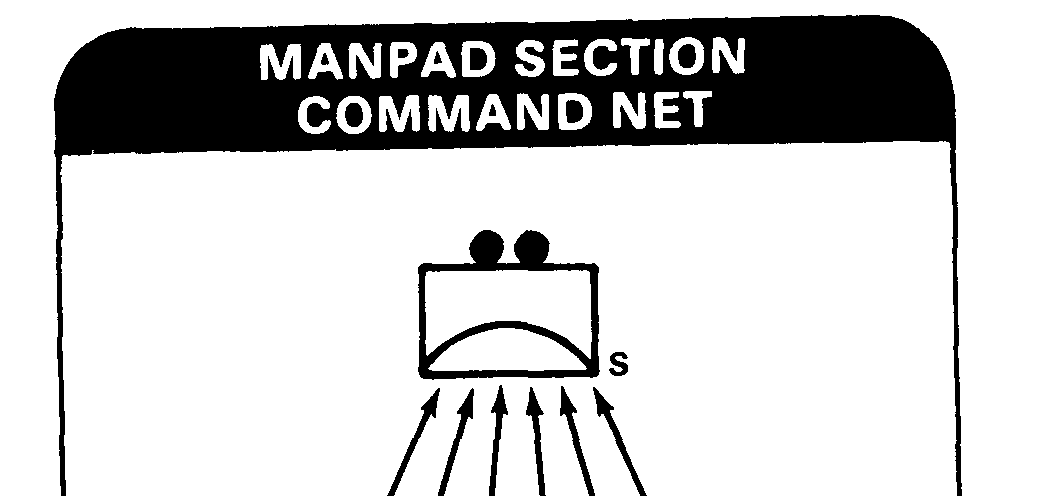

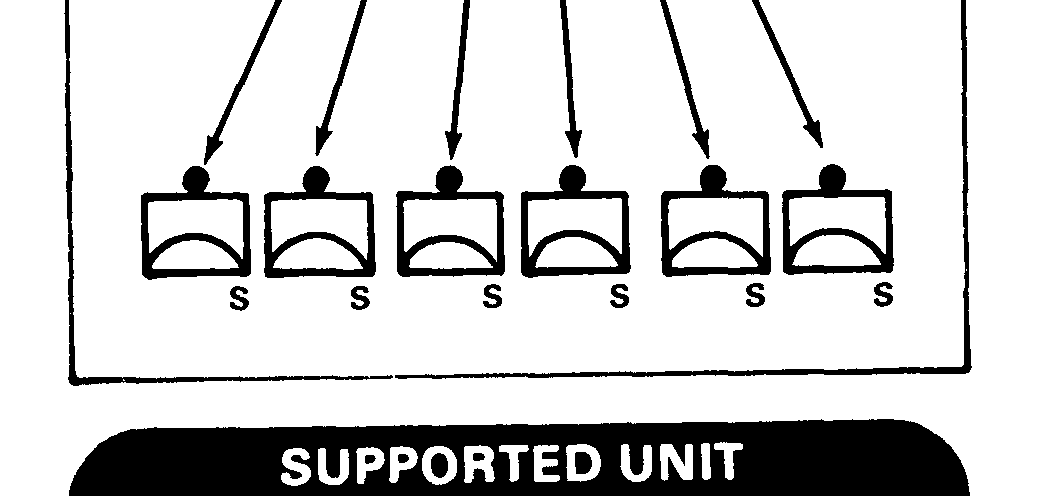

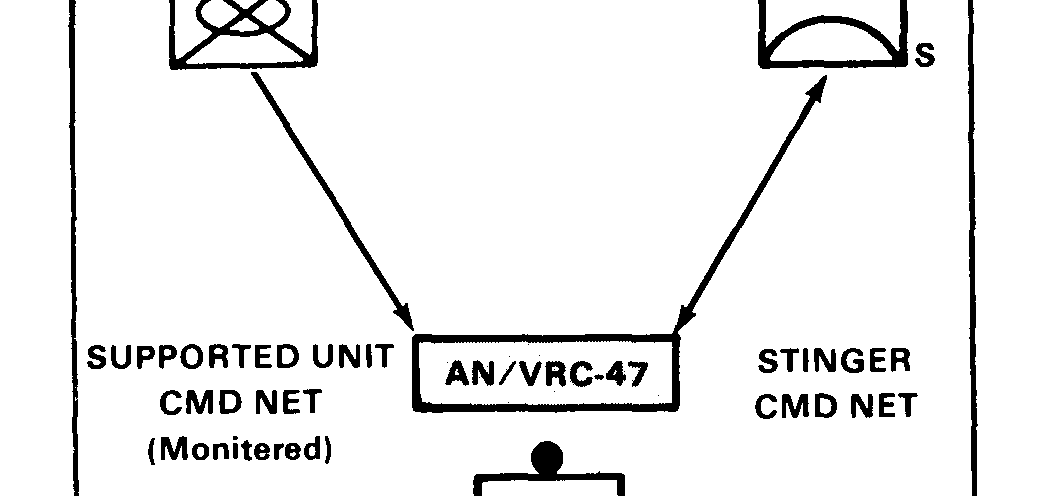


FM 44-18-1
COMMUNICATIONS
Because MANPAD teams are widely
dispersed and subject to frequent and rapid
moves, radio is the primary means of com-
munications during employment. Radio nets
are supplemented and paralleled by wire nets
when time, the tactical situation, and secur-
ity permit their use.
The MANPAD team operates in the sec-
tion command net when not assigned a direct
support role. This is a two-way net linking the
section headquarters and its assigned teams.
Information received over the command net
includes the following:
Air defense warning and orders.
Movement orders.
Command and control information.
Any other information essential for sec-
tion operations.
MANPAD teams may be assigned to
support armored, infantry, mechanized
(AIM) divisions, separate brigades, armored
cavalry regiments, and corps/theater
artillery/ADA battalions. These teams are
equipped to operate in one net and monitor
another. Monitoring the section/FAAR net
alerts the team to early warning information.
To do all this, the team is authorized an
AN/VRC-47 radio.
Teams may also be assigned to support
airborne and air-assault units. MANPAD
teams with an airborne division are equipped
with one AN/ GRC-160 radio set. Teams oper-
ate in the section command net and the sup-
ported unit command net when autonomous.
Teams with an air-assault division are equip-
ped with two AN/PRC-77 for use in both the
MANPAD command net and the supported
unit command net.
7-5
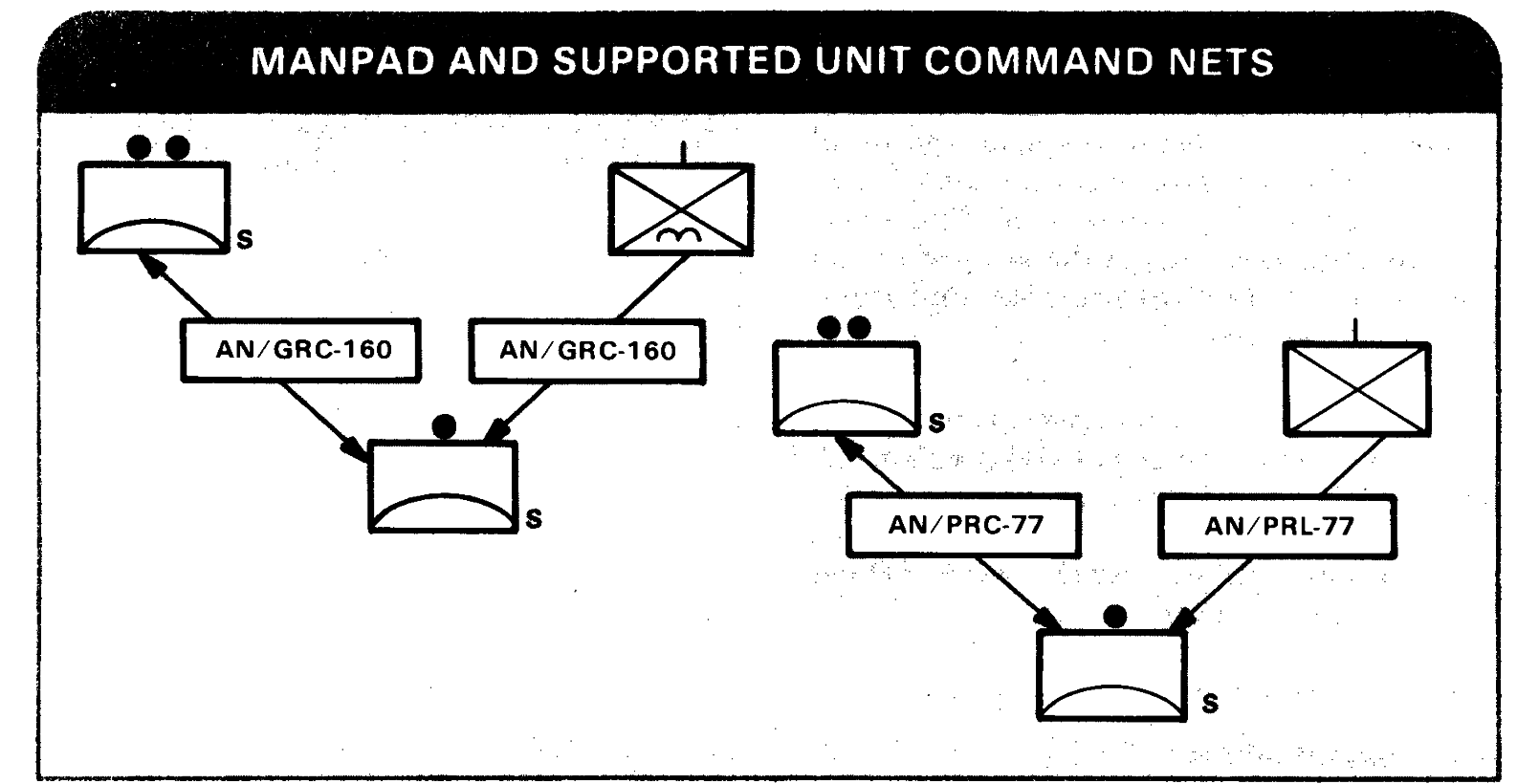
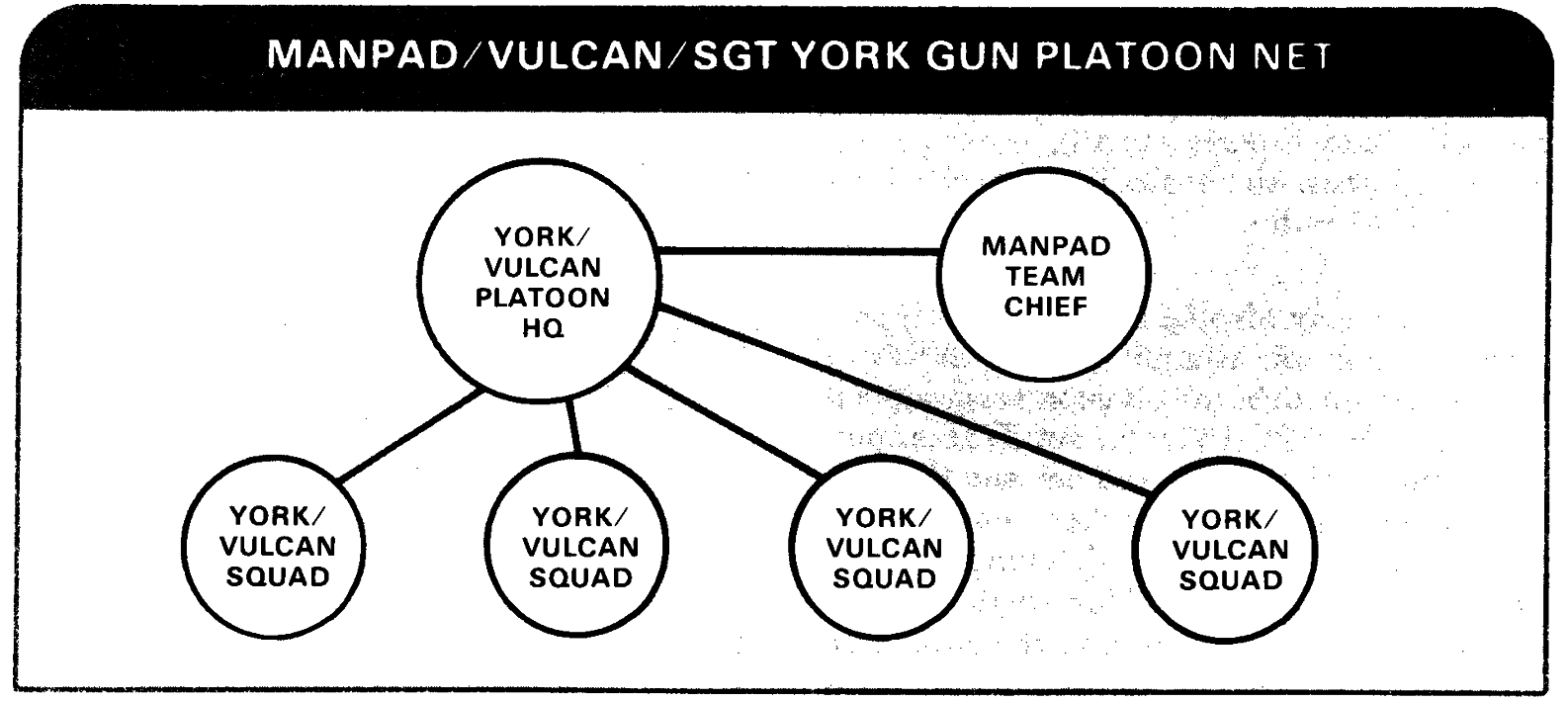
FM 44-18-1
When a Vulcan/SGT York Gun platoon
changes in WCS, air defense warning, alert
is in direct support of a company team which
status, and other information given to the
is also supported by MANPAD, the Vulcan/
Vulcan/SGT York Gun platoon. This method
SGT York Gun platoon leader, Vulcan/SGT
insures coordination of the air defense effort.
York Gun squads, and MANPAD team(s)
If the MANPAD section chief needs to get
operate in the Vulcan/SGT York Gun pla-
information to his team, he can contact the
toon net. By joining the Vulcan/SGT York
Vulcan/SGT York Gun platoon leader who
Gun platoon command net, the team will
can pass on the information.
receive all early warning information,
7-6





FM 44-18-1
AN/VRC-47
AN/PRC-77
The AN/VRC-47 combines the RT-524\
This radio set is a short-range, light-
VRC with one additional receiver, the
weight, fully transistorized radio set that can
R-442/VRC. This radio set monitors one net
be either vehicle-mounted or man-carried.
while operating in another.
AN/GRA-39
AN/GRC-160
The RT-524 can be remoted, using the
The AN/GRC-160 incorporates the com-
AN/GRA-39 radio set control group. This
ponents and operational characteristics of
battery-operated remote control system con-
the portable FM radio set AN/PRC-77 and
sists of a local control unit and a remote con-
the vehicular radio set AN/VRC-64.
trol unit. When connected to the radio with
field wire, the AN/GRA-39 (remote set) can
operate the radio from a distance of up to 3.2
SPEECH SECURITY EQUIPMENT
kilometers (2 miles). By using this remote
control unit, MANPAD personnel can com-
All the above radio equipment can be
municate while away from their vehicles.
operated with speech security equipment.
RADIO COMMUNICATIONS
The team radio operator must be able to
Speak slowly and distinctly at normal
effectively communicate in a radio net. To do
voice level directly into the microphone, just
this, he must use correct radiotelephone pro-
as you would into a conventional telephone.
cedures. Radiotelephone procedures must be
Do not key the mike for longer than 15
used properly to prevent targeting the radio
seconds. Use “breaks” for long transmissions.
and giving the enemy useful information.
Radiotelephone procedures are based on the
N E T S
Allied Communication Publication (ACP)
series of publications.
The type of net is determined by the NCS
according to operating conditions. The types
NET CONTROL
of nets are free and directed.
Each radio is controlled by a net control
In a free net, traffic is exchanged without
station (NCS) which maintains circuit disci-
prior permission from the NCS. A net is
pline within the net. The following are fun-
deemed to be a free net unless otherwise
damentals that must be used when operating
ordered by the NCS.
in a radiotelephone net:
In a directed net, stations must obtain
permission from the NCS prior to conducting
First, write down your message.
communications with other stations.
Listen before transmitting to avoid inter-
fering with other transmissions.
CALL SIGNS
Start speaking as soon as you key the
A call sign is a letter-number-letter com-
mike. (Do not wait for the sound of the blower bination assigned to a unit. Every unit in an
motor to peak out.)
organization has a different call sign. The
Speak in natural phrases, not word by
complete call sign is used under the following
word.
conditions:
7-7





FM 44-18-1
When opening and closing a net.
radio’s technical manual for instruction on
When entering a net in which you do not
how to do this.
normally operate.
RADIOTELEPHONE PROWORDS
When responding to a net call.
Certain commonly used prowords have
When requested by the NCS or any other
distinct meanings and are used to shorten the
station.
amount of time in voice communications and
When radio reception is poor.
to avoid confusion. These prowords should be
used when talking on the radio or the tele-
CALL SIGN SUFFIXES
phone.
Call sign suffixes are two-numbered
groups assigned to positions or activities
AUTHENTICATION
within a unit. The call sign and suffix together
identify the sender and receiver of a radio
Authentication is required when—
message.
Opening and closing a net.
FREQUENCIES
Entering a new net.
Each radio net is assigned a frequency.
Coordinates of a position are requested.
These frequencies are established by the
Directions are given to move or which
communications-electronics operation instruc-
tions (CEOI). Radio operators should be adept
otherwise affect the tactical situation.
at changing radio frequencies. Refer to the
Any degradation of ADW or WCS.
TEAM WIRE COMMUNICATIONS
FIELD TELEPHONE
Team positions may be interconnected
Each Stinger team is issued two TA-
by wire for local communications in static
1/PT telephone sets. The TA-1 is a sound-
situations or during listening or radio silence.
powered telephone that provides facilities for
When the support unit establishes its wire
talking and signaling without batteries. It
system, the team can communicate with its
weighs only 3.5 pounds and has a range, with
section headquarters by wire. Information on
field wire, of approximately 10-15 kilometers.
how to connect a field telephone and use of
This telephone set can be used to advantage
field wire is found in FM 24-20.
in forward areas, employed in switched wire
Members of split teams also use wire to
networks (during periods when radio nets are
communicate. Because only one radio and
closed), or as point-to-point circuits.
one TADDS are within the team, the team
WIRE
chief stays with the radio and TADDS. The
gunner lays wire to the second position,
Each team is issued one RL-39 reeling
attaches the field telephone, and establishes
machine with a DR-8 reel containing 0.4
communications with the team chief. A
kilometer (Vi mile) of field wire. A second reel
second reel of wire is required to accomplish
can be obtained from the parent unit. This
this.
combination can be used to lay short local
7-8






FM 44-18-1
circuits between field telephones and between
recoverable and is reusable; it should always
the RT-524/VRC radio location and the AN/
be taken up before moving out of a position, if
GRA-39 remote control unit. Field wire is
the situation permits.
TEAM VISUAL SIGNALS
Arm and hand signals may be used by
movements for the tank and mechanized
team members to communicate among them-
infantry company team are covered in FM
selves and with supported unit personnel.
71-1. When MANPAD teams are supporting a
Arm and hand signals are useful when radio
maneuver unit, they they should be familiar
or wire is not available and battlefield noise
with the visual signals used by leaders of the
does not permit use of voice commands. Arm
unit. FM 21-60, Visual Signals, contains a
and hand signals should be used only when
complete list of each type of visual signal. Six
absolutely necessary. Standard and special
examples of arm and hand signals for the
hand-and-arm signals to control small unit
communications of MANPAD fire commands
actions, recovery operations, and vehicle
are shown in the illustration below.
7-9







FM 44-18-1
ALERT WARNINGS
FAAR/TADDS SYSTEM
An alert warning is an early warning, or
The FAAR/TADDS system is the prim-
indication of air attack.
ary means of providing MSCS alerting infor-
mation to the MANPAD team. This informa-
APPROACH WARNINGS
tion is transmitted by radio to the TADDS
A MANPAD team may be warned of an
receiver located with the team.
approaching aircraft or it may visually detect
the target without prior warning. Warning of
the approach of an aircraft increases the
chances of successfully engaging it. An alert
FAAR
warning will usually give general location
The FAAR system is a self-contained,
and heading of the aircraft and a tentative
pulse-doppler search radar system. Its mis-
identification (see appendix A). The FAAR,
sion is to provide early warning in the form of
together with the TADDS, furnishes early
general target location and tentative identi-
warning to the team. The team may also
fication. This early warning is provided to
receive early warning/alert information from
TADDS receivers located at divisional
the section headquarters. This data is re-
SHORAD fire units and headquarters up to
ceived at the section headquarters from the
platoon level. The range of the FAAR is 20
early warning broadcast net (EWBN), the air
kilometers. The FAAR transmits informa-
defense control net (ADCN), or the FAAR. In
tion to the TADDS using an AN/VRC-46 FM
turn, section headquarters sends this infor-
radio. Since the AN/VRC-46 is an FM radio,
mation to the MANPAD teams over the sec-
line of sight is necessary between the FAAR
tion command net.
and the TADDS.
7-10


FM 44-18-1
Several FAARs will normally be operat-
ence, are being received. Emplacement of the
ing in a divisional area. Each has a different
TADDS is quickly accomplished by one man.
address code. Also, each is assigned a differ-
The operator performs the operational checks
ent frequency in the CEOI. The MANPAD
listed in TM 9-1430-589-12 to insure proper
section chief usually obtains the location of
operation.
the nearest operating FAAR from the pla-
toon headquarters. If a team cannot achieve
line of sight with a FAAR, another position
Using The TADDS
may have to be chosen. FAAR positions may
The team chief tunes the TADDS receiver
change during a battle. Therefore, the section
to the frequency and address code of the
chief must know where the FAAR positions
nearest FAAR. If no signal is received, he
are located at all times.
then consults the CEOI for the frequency and
code of other FAARs. If he receives a signal,
TADDS
he informs his section chief and requests the
The TADDS is a lightweight receiver
coordinates of that FAAR.
which can receive alert information sent
Long-range early warning information
from a FAAR. The TADDS has the capability
from the SHORAD TOC and locally gener-
of receiving voice transmission over its FM
ated FAAR early warning are received over
radio receiver. This is is now the primary
the TADDS FM receiver from the nearest
means for passing alert information.
FAAR section. The MANPAD team must
monitor the team’s respective platoon or sec-
Site Selection
tion command net, and either the supported
For the best reception, a site for the
unit command net or the EWBN. The teams
TADDS is selected which allows as close to a
monitor the FAAR on the TADDS FM re-
clear line of sight to the FAAR as possible
ceiver. It must be emphasized that the TADDS
(see illustration). The keyed characteristic of
is used exclusively as an FM receiver to the signal, when heard from the speaker,
receive early warning information from the
indicates that data link signals, not interfer-
FAAR.
7-11









FM 44-18-1
RELATIONS WITH SUPPORTED UNIT
The team chief must coordinate with the
some do’s and don’ts to keep in mind to pro-
supported unit commander or his representa-
mote a good relationship and good coordina-
tive as soon as he can after being given his
tion on a local level:
mission. Good relations between the team
Advise the supported commander on air
and the supported unit are a must. The team
defense matters.
chief should be prepared to offer advice on air
defense matters and keep the supported unit
Don’t do anything that might compromise
commander informed of ongoing air activity
the security of the supported unit.
as he receives it through his ADA channels.
Follow the movement plan carefully.
It is the team chiefs responsibility to warn
When directed to occupy a specific posi-
the supported unit regarding safety hazards
tion, do so as quickly as possible.
(backblast and noise, see page 2-4.). It then
becomes the unit’s responsibility to take the
When attached, coordinate on-site selec-
proper protective measures (for example,
tion with the unit commander.
wearing ear plugs and moving away from the
Be courteous and tactful in all dealings
backblast area). If such items as team mess-
with the supported personnel and, in particu-
ing, resupply, refueling, need to be taken care
lar, with the supported commander. You are
of, the team chief will have to coordinate this
there to complement his defense measures by
with the supported unit. The following are
your air defense contribution.
HOW TO OPERATE AS A SPLIT TEAM
Under certain conditions and/or situa-
craft is detected.
tions a team may have to be split. Splitting
When separated from the team chief, the
the team degrades command and control and
gunner is fully responsible for correct identi-
the ability to detect, positively identify, and
fication of any aircraft which he engages (see
engage aircraft. If a team has to operate in a
chapter 4 for proper identification proce-
split manner, the following points should be
dures).
given serious consideration:
Split the basic load; two complete weapons
and one missile-round per team member.
When operating as a split team the land
The team chief should have access to the
line (field telephones) are the only means of
radio.
communications between the teams. The
maximum distance for splitting the team
The team chief should relay command and
should be 1/4 mile. When hand signals are the
control information to the gunner over the
only means of communications between the
team wire net.
split team, if feasible, the split team should be
Each team member keeps the other in-
positioned so that each team has a line of
formed of any activity, such as when an air-
sight to each position.
7-12

FM 44-18-1
PROTECTING A CONVOY OR MANEUVER UNIT WITH MANPAD
WEAPONS
When protecting a convoy, MANPAD
craft. If not destroyed, the aircraft will at
personnel normally engage aircraft only if
least have his ordn
















































